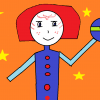Hello everyone, I've recently finished quite a few games I had put on hold for a while, and I feel like I'm now quite comfortable making simple games without sprite animation, and lots of the difficulties went away, so, I want to get started making sprite sheets and animation, does anyone have any advice on where I can get started/ what are programs I can use? Should I draw by hand or draw on computer? I'm currently using Allegro5 and C++. Thank you so much :).
Help getting started creating sprite sheets and sprite animation
Are you looking for a specific style? Retro sprites (what people have taken to calling 8-bit or 16-bit) are generally done on a computer using image editing programs that may or may not be specialized for sprite work. The last time I was poking around GraphicsGale was a big deal, but that was years ago. You can find some lists on google that recommend various programs. I think the key is to check around and find the one that's the most comfortable to you and offers the features you like.
This list mentions most of the ones I've heard of or used: http://www.slant.co/topics/1547/~pixel-art-sprite-editors
If you have a tablet you may want to peek at your app store as well.
You might want to ask the question in the Visual Arts subforum (maybe a mod can move the Thread).
You can basically use ANY graphics software to create sprites. I personally like Manga Studio / Clip Studio Paint, for what you pay the current version is spectacularly good. Especially on slower hardware and mobile (Windows) devices, it outshines Photoshop without any problems. It runs happily on a mobile CPU with only 4GB RAM without noticable slowdown even with bigger resolutions, and the stroke stabilization is really handy for use on the often not so accurate digitizers and small screens of mobile tablets.
Photoshop is pretty much the industry standart. Thanks to the CC Version, you can get Photoshop nowadays without needing 2000$ initially (Altough being sub based, the cost will add up over time of course).
Then there is the Gimp. Opensource alternative to Photoshop, you get most of the functionality of PS (and some things you don't get with stock PS) for free.
Both are of course quite big and complex tools to learn...
There is a multitude of other Art tools for digital Drawing. Leaving away Painter for now (because it is resource hungry, and more useful for artists trying to replicate the look and feel of traditional media), there is Sketchbook pro and Artrage. Both seem to aim to give digital drawing a simpler and more intuive interface. I was impressed with sketchbook pro when I tried it.
There is Mischief which comes with some new ideas and seems to be beloved by many digital artist because of that.
For Pixel Arts, you will find a whole host of tools that might help you. Given that you work with extremly low resolutions, about any tool will do. Some might make life easier than other though.
Because I haven't personally tried any of these, here are some links:
Personally I would recommend getting a drawing tablet of some sort and work digitally. Works best for me. They start at 50-100$ for a basic wacom Bamboo, which might be enough to get you started. If you can splash out more, you could get a wacom cintique, MS Surface or a similar device from a less known Brand. Though now we are talking about 1000$+ devices, and still 500$+ for the lesser known brands or a basic MS Surface non-pro.
Of course, for low resolution pixel art pen input might not be as necessary. A mouse would most probably do just as fine. And given your train a little bit painting with the mouse, you could also create normal digital art with the mouse (though with not so expensive entry level tablets available, I personally would get a Wcom Bamboo first before trying to create complex digital art with a mouse).
Working the traiditional way, and then scanning and cleaning up on PC is of course also possible. Some artists still prefer that. You still need to scan your images though, and clean up on PC, so you are not really saving much by going that route.







